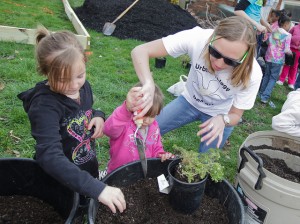
Sam Griffith ’13 helps children from the Easton Area Community Center plant flowers.
Five students rolled up their sleeves and got their hands dirty—literally—through a series of art projects over the last year.
The Technology Clinic class undertook a project called “Urban Art as a Form of Urban Ecology in the West Ward.” A central theme the students emphasized is sweat equity, the idea that when people create art, they are more likely to feel a sense of pride and ownership over it, thus fostering community pride as well.
Successfully planning and completing the community art projects were government and law majors Andrew Chun ’12 (Monroe, N.Y.) and Hamish MacPhail ’13 (Bedford, Mass.), English and history double major Sam Griffith ’13 (Ocean City, N.J.), geology and anthropology & sociology double major Anne Bond ’13 (Radnor, Pa.), and chemical engineering major Szu-Ying “Sandy” Chen ’13 (Bangkok, Thailand).
The team reached out to a variety of local organizations, including the Easton Area Community Center, Boys and Girls Club of Easton, and West Ward Neighborhood Partnership. What they found was overwhelming community support, with passers-by asking to join in the action when they saw their friends and neighbors sprucing up their neighborhoods. In all, the team organized four art festivals, including a flower installation in the spring and fall, a portable mural festival, and two chalk festivals.
The students weren’t interested in providing community children with rigidly structured projects; rather, they wanted to create a loose framework and, most importantly, access to the tools they’d need to let their creativity blossom. Their final report laid out plans for each festival, including contacts, pricing, and future suggestions, so the community can take the reins and make them annual events.
“Children are interested in art and personal expression,” explains MacPhail. “Whether through performance art, visual art, or even athletics, kids want to be known for success. Not all children are given the tools and guidance to create art. Tech Clinic helped provide resources and tools to create an initial engagement for art.”
Case in point: During the fall flower festival, the team worked with children from the community center to make a jack-o-lantern flower installation at Eighth Street Park off Northampton Street. Adults and kids walking by volunteered to help move mulch and place and water the flowers. For weeks afterwards, the kids brought family and friends to the park to show off their work. Easton Mayor Sal Panto was so pleased that he suggested making the site a permanent flower installation and expanding the project to the city’s other pocket parks. The installation was never vandalized and the community came together to care for it, showing the power of sweat equity.
That’s what makes Tech Clinic so different from other classes. Larry Malinconico, associate professor of geology and environmental geosciences, and Dan Bauer, professor emeritus of anthropology and sociology, direct the hands-on course that brings together students from different majors to help solve real-world problems of a business, nonprofit organization, or government body.
Chun, who hopes to use his environmental science minor to land a consulting job after graduation, says the team felt real pressure to do the job right.
“It was up to our team to come up with solutions on our own. If we failed, then it was our fault, and we failed not only our professors, but the community as a whole, so we knew we had to be on time and account for every possibility,” he says. “We had our ups and downs, but we learned to work together and draw on each other’s strengths and help each other through our weaknesses to have success. That’s not an experience you can get from a textbook. Getting out there in the real world and not having the safety net of a classroom taught me a lot.”
For the portable mural festival at the community center, the team asked children what Easton means to them. Using their responses as a guide, campus artists sketched three murals on portable Tyvek and invited the children to paint them. The artists included Griffith and Drawing I students taught by Nestor Gil, assistant professor of art, psychology and art double major Meghan Miklavic ’12 (Elizabeth, Maine) and art major Will Rockafellow ’14 (Rosemont, Pa.).
“If the kids are more invested in their projects and community, their families are more likely to be as well,” says Bond. “Art not only beautifies the area, it can really bring a community together, which consequently can raise property values and has a positive economic impact. I liked working on real-life problems with real people through Tech Clinic. We were working on something that could make a difference.”
